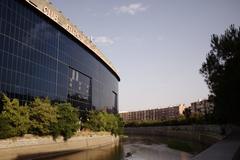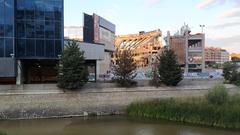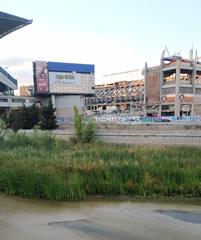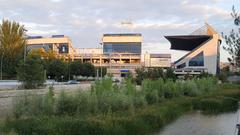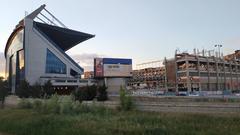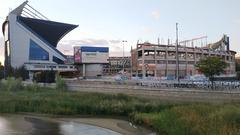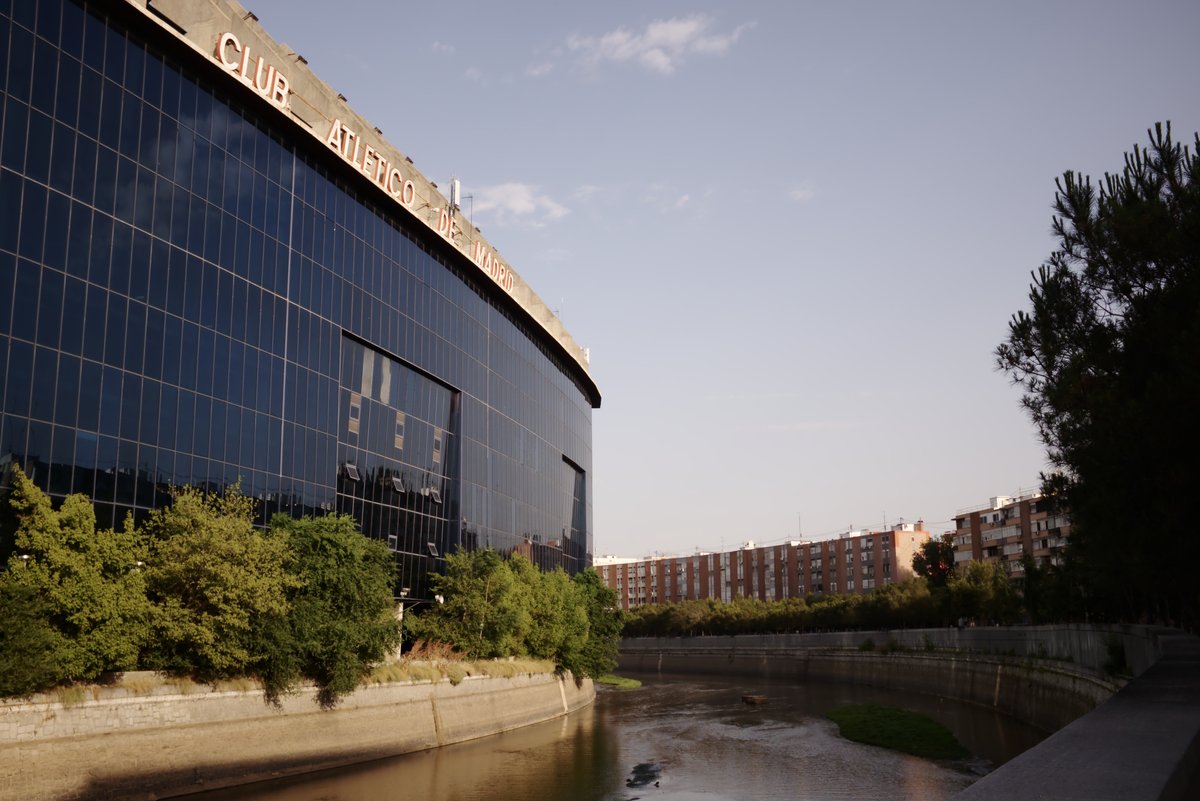
Vicente Calderón Stadium: Visiting Hours, Tickets, and Historical Significance in Madrid
Date: 14/06/2025
Introduction
Vicente Calderón Stadium was more than a football ground—it was a cornerstone of Madrid’s urban and sporting landscape, and a vibrant symbol of Atlético Madrid’s working-class roots. Though demolished in 2020, its legacy endures in the city’s collective memory and through the new Mahou-Calderón Park, which honors the stadium’s enduring place in Madrid’s culture and football history. Today, fans and visitors can explore the site’s commemorative elements, enjoy its green spaces, and delve into Atlético Madrid’s storied past at the club’s museum in the Wanda Metropolitano Stadium (Madrid Metropolitan, World Soccer, esmadrid.com).
Table of Contents
- Origins and Construction
- Architectural Significance
- Cultural Impact and Key Moments
- The Heart of Atlético Madrid
- Visiting the Vicente Calderón Site Today
- Visitor Information: Hours, Tickets, Accessibility
- Frequently Asked Questions (FAQ)
- Visual & Media Recommendations
- Related Articles and Links
- Conclusion & Final Recommendations
- References
Origins and Construction
The stadium’s story began in the 1950s, as Atlético Madrid outgrew its previous ground. Officially opened in 1966 as Estadio Manzanares, its location on the banks of the Manzanares River shaped its identity from the start. The stadium was renamed in 1971 to honor Vicente Calderón, the club’s long-serving president, whose leadership was fundamental during a transformative era for the club (Madrid Metropolitan, Football Tripper).
Architectural Significance
Designed by Antonio Lamela, the stadium was celebrated for its innovative architecture, notably the main stand built directly over the M-30 motorway—a rare feat in world football (esmadrid.com). Its modernist design emphasized sweeping concrete terraces and an intimate seating plan, helping to create a cauldron-like atmosphere that brought fans close to the action. The four main stands—Fondo Norte, Lateral (East), Fondo Sur, and Preferencia (West)—held over 54,900 spectators at its peak (World Soccer).
Cultural Impact and Key Moments
Vicente Calderón was the beating heart of Atlético Madrid for over five decades. It hosted 1,227 official matches, including 775 victories for the home side, and notable events such as La Liga and Copa del Rey triumphs. The stadium also staged 14 Copa del Rey finals and three matches during the 1982 FIFA World Cup, solidifying its place in Spanish football history (Daily Star). Legendary players such as Raúl, Fernando Torres, and Diego Forlán graced its turf, and the venue became synonymous with Atlético’s most passionate supporters.
Its influence reached beyond football, regularly hosting major concerts by the likes of The Rolling Stones, Michael Jackson, and Bruce Springsteen, further establishing the stadium as a central hub of Madrid’s cultural life.
The Heart of Atlético Madrid
More than a venue, Vicente Calderón was a symbol of Atlético’s identity and the spirit of its fanbase. The stadium’s location in the Arganzuela district, near the Mahou brewery and the Manzanares River, reflected the club’s deep roots in working-class Madrid (World Soccer). Matchdays were ritualistic, with fans gathering in local bars and cafes, such as Cervecería Alegre and La Esquina del Calderón, before journeying together to the stadium. This created a sense of community and pilgrimage that defined Atlético’s culture.
Visiting the Vicente Calderón Site Today
Mahou-Calderón Park
Following its closure in 2017 and demolition by 2020, the Vicente Calderón site was redeveloped as Mahou-Calderón Park. The park is free and open to the public, offering green spaces, over 1,200 new trees, running tracks, and commemorative features such as a stone plaque marking the stadium’s years of operation (1966–2017) and a time capsule beneath the former pitch (esmadrid.com).
Commemorative Features
- Stone Plaque: Carved with the image and name of the stadium.
- Time Capsule: Contains stadium memorabilia, including a seat and historic photographs.
- Photographic Spots: Dedicated areas for fans and visitors to reminisce and capture memories.
Museum and Club Heritage
Atlético Madrid’s museum at Wanda Metropolitano offers interactive exhibits, trophies, and memorabilia—including artifacts from the Calderón era (Atlético de Madrid Official Museum). Guided tours showcase the club’s evolution and connection to its former home.
Visitor Information: Hours, Tickets, Accessibility
Mahou-Calderón Park
- Hours: Open daily from dawn until dusk.
- Admission: Free entry; no tickets required.
- Accessibility: Fully wheelchair accessible with paved paths and ramps.
Getting There
- Metro: Pirámides and Marqués de Vadillo stations (Line 5).
- Cercanías Train: Lines C-1, C-7, C-10 (Pirámides station).
- Bus: Lines 17, 18, 23, 35, 36, 50, N16, N26.
- Walking: About 4.2 km (2.6 miles) from Puerta del Sol.
Nearby Sights
- Madrid Río Park: Riverfront green space and recreation.
- Puente de Toledo: Historic bridge.
- Matadero Madrid: Contemporary arts center.
Atlético de Madrid Museum (Wanda Metropolitano)
- Hours: Generally 10:00 AM–6:00 PM (check official site for updates).
- Tickets: Purchase online or at the museum; discounts for children and seniors.
- Accessibility: Fully accessible via Metro Line 7 (Estadio Metropolitano station).
Frequently Asked Questions (FAQ)
Q: Can I visit Vicente Calderón Stadium today?
A: No, the stadium was demolished in 2020. However, you can visit Mahou-Calderón Park, which occupies the former site.
Q: Are there guided tours available?
A: There are no official tours of the park, but the site is included in some football heritage tours of Madrid. Guided tours of Atlético’s history are available at Wanda Metropolitano.
Q: Is there an entrance fee to visit the park?
A: No, entry to Mahou-Calderón Park is free.
Q: Where can I find memorabilia from Vicente Calderón?
A: The Atlético de Madrid Museum at Wanda Metropolitano features exhibits from the Calderón era.
Q: What are the park’s visiting hours?
A: Open from dawn until dusk, year-round.
Visual & Media Recommendations
- Include photographs of the former stadium, the commemorative plaque, and the new park.
- Feature images of Atlético de Madrid Museum exhibits and Wanda Metropolitano.
- Use alt tags such as “Vicente Calderón Stadium history” and “Atlético de Madrid Museum exhibits” for SEO optimization.
Related Articles and Links
Conclusion & Final Recommendations
The spirit of Vicente Calderón Stadium lives on through Mahou-Calderón Park, the passionate community of Atlético fans, and the club’s museum. While the stadium itself may be gone, its legacy is indelible—woven into the city’s fabric and celebrated at every corner of Madrid’s football culture. To truly appreciate this legacy, visit the park, explore the museum, and immerse yourself in the traditions that continue to define Atlético Madrid.
For updated travel tips and immersive audio tours, download the Audiala app, follow our social channels, and share your experiences to help keep the memory of Vicente Calderón alive.
References
- Vicente Calderón Stadium History, Visiting Information & Madrid’s Iconic Football Landmark, 2024, Madrid Metropolitan (Madrid Metropolitan)
- Vicente Calderón Stadium: History, Cultural Significance, and Legacy of Madrid’s Iconic Football Ground, 2024, World Soccer (World Soccer)
- Vicente Calderón Visiting Hours, Tickets & What to See at Madrid’s Historic Football Site, 2024, What to Do in Madrid (What to Do in Madrid)
- Vicente Calderón Stadium: History, Visitor Info & Legacy of Madrid’s Iconic Football Ground, 2024, esmadrid.com (esmadrid.com)
- Vicente Calderón Stadium: History, Visitor Info & Legacy of Madrid’s Iconic Football Ground, 2024, Atlético de Madrid Official Website (Atlético de Madrid Official Museum)
- Vicente Calderón Stadium: History, Cultural Significance, and Legacy of Madrid’s Iconic Football Ground, 2024, Daily Star (Daily Star)
